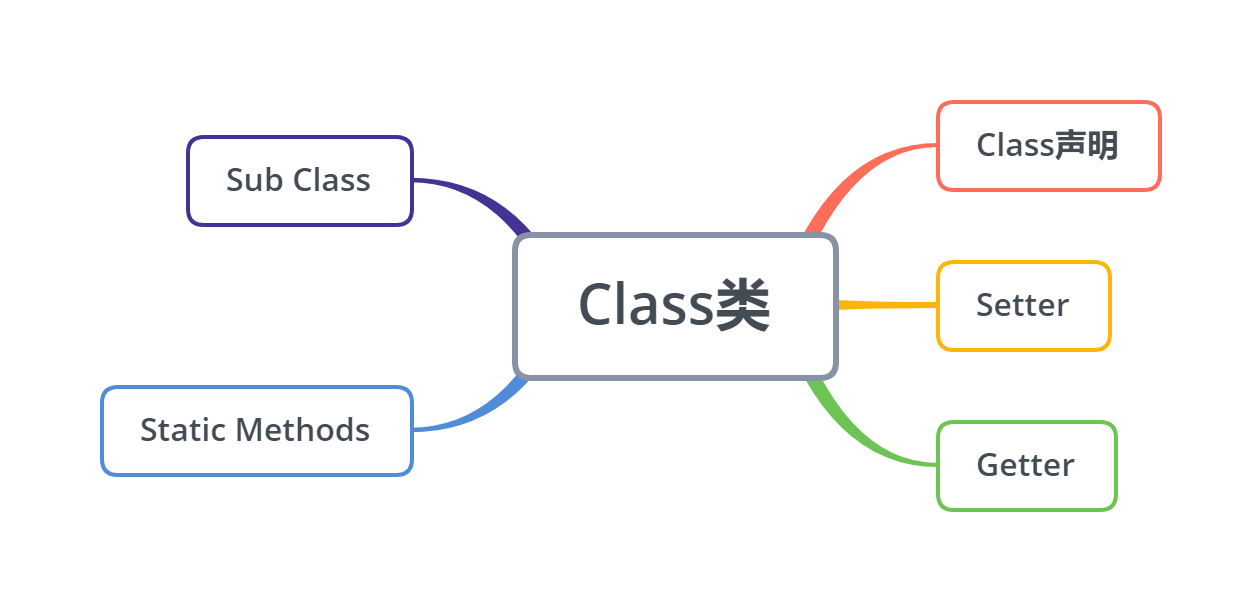ES6-10笔记(二)
class类

Javascript是一种基于对象(object-based)的语言,你遇到的所有东西几乎都是对象。但是,它又不是一种真正的面向对象编程(OOP)语言,因为它的语法中没有class(类)。摘自阮一峰老师语录
class声明
ES5的JavaScript中只有对象,想要模拟类去生成一个对象实例,只能通过定义一个构造函数,然后通过new操作符来完成。
let Animal = function (type) {
this.type = type
}
Animal.prototype.walk = function () {
console.log(`I am walking`)
}
let dog = new Animal('dog')
let monkey = new Animal('monkey')
//构造函数生成实例的执行过程
1.当使用了构造函数,并且new 构造函数(),后台会隐式执行new Object()创建对象;
2.将构造函数的作用域给新对象,(即new Object()创建出的对象),而函数体内的this就代表new Object()出来的对象。
3.执行构造函数的代码。
4.返回新对象(后台直接返回);
ES6引入了Class(类)这个概念,通过class关键字可以定义一个类
class Animal {
constructor (type) {
this.type = type
}
walk () {
console.log(`I am walking`)
}
}
let dog = new Animal('dog')
let monkey = new Animal('monkey')
但是Class的类型还是function,并且console.log(Animal.prototype);结果几乎是一样的,所以可以认为class声明类的方式是function声明类方式的语法糖。甚至在class声明类后仍可使用ES5的方式来为这个类添加,覆盖方法。
console.log(typeof Animal); //function
ES5中打印的console.log(Animal.prototype)
//{eat: ƒ, constructor: ƒ}
//eat: ƒ ()
//constructor: ƒ (type)
//__proto__: Object
ES6中打印的console.log(Animal.prototype)
//{constructor: ƒ, eat: ƒ}
//constructor: class Animal
//eat: ƒ eat()
//__proto__: Object
除了constructor后边分别是f(type)和class Animal
class不存在变量提升,所以需要先定义再使用。因为ES6不会把类的声明提升到代码头部,但是ES5就不一样,ES5存在变量提升,可以先使用,然后再定义。
//ES5可以先使用再定义,存在变量提升
new A();
function A(){
}
//ES6不能先使用再定义,不存在变量提升 会报错
new B();//B is not defined
class B{
}
Setters&Getters
类中的属性,可以直接在constructor中通过this直接定义,还可以通过get/set直接在类的顶层定义
class Animal {
constructor (type, age) {
this.type = type
this._age = age
}
get age () {
return this._age
}
set age (val) {
this._age = val
}
}
get可以定义一个只读属性
class Animal {
constructor (type) {
this.type = type
}
get addr () {
return '北京动物园'
}
}
get/set可以进行一些简单封装,如下
class CustomHTMLElement {
constructor (element) {
this.element = element
}
get html () {
return this.element.innerHTML
}
set html (value) {
this.element.innerHTML = value
}
}
get/set还可以模拟设置私有属性,并可以通过get和set对获取属性和读取属性进行一些逻辑判断
let _age = 4
class Animal{
constructor(type) {
this.type = type
}
get age() {
if(this.type == 'dog'){
return _age
}else{
return "I don't know"
}
}
set age(val){
if(val<7&&val>4){
_age = val
}
}
eat () {
console.log('i am eat food')
}
}
let dog = new Animal('dog')
let cat = new Animal('cat')
console.log(dog.age)//4
console.log(cat.age)//I don't know 在get age中只有dog能拿到_age
dog.age = 6
console.log(dog.age)//6
dog.age = 8
console.log(dog.age)//6 在set age中传入参数必须小于7大于4才能生效
继承
ES5中继承的实现
// 定义父类
let Animal = function (type) {
this.type = type
}
// 定义方法
Animal.prototype.walk = function () {
console.log(`I am walking`)
}
// 定义静态方法
Animal.eat = function (food) {
console.log(`I am eating`)
}
// 定义子类
let Dog = function () {
// 初始化父类
Animal.call(this, 'dog')
this.run = function () {
console.log('I can run')
}
}
// 继承
Dog.prototype = Animal.prototype
ES6中通过extends关键字实现继承。
子类必须在constructor方法中调用super方法,之后才能使用this关键字,否则新建实例时会报错。这是因为子类没有自己的this对象,而是继承父类的this对象。如果不调用super方法,子类就得不到this对象。在这一点上ES5的继承与ES6正好相反,ES5先创建自己的this对象然后再将父类的属性方法添加到自己的this当中。
如果子类没有显式的定义constructor,那么下面的代码将被默认添加(不信可以尝试下,哈)。换言之,如果constructor函数中只有super的话,该constructor函数可以省略。
class Animal {
constructor (type) {
this.type = type
}
walk () {
console.log(`I am walking`)
}
static eat () {
console.log(`I am eating`)
}
}
class Dog extends Animal {
constructor () {
super('dog')
}
run () {
console.log('I can run')
}
}
静态方法 static Methods&静态属性
静态方法是面向对象最常用的功能,在ES5中利用function实现的类是这样实现一个静态方法的
let Animal = function (type) {
this.type = type
this.walk = function () {
console.log(`I am walking`)
}
}
Animal.eat = function (food) {
console.log(`I am eating`);
}
在ES6中使用static的比纳基是不是静态方法
class Animal {
constructor (type) {
this.type = type
}
walk () {
console.log(`I am walking`)
}
static eat () {
console.log(`I am eating`)
}
}
静态方法不需要实例化可以直接通过类调用
class Animal{
static a(){
return "我是Animal类中的,实例方法,无须实例化,可以直接调用"
}
}
//通过类名直接调用
console.log(Animal.a());//我是Animal类中的,实例方法,无须实例化,可直接调用!
静态方法只能在静态方法中调用,不能在实例方法中调用
class Animal{
static a(){
return "我只允许被静态方法调用哦!"
}
static b(){
//通过静态方法b来调用静态方法a
console.log(this.a());
}
}
Animal.b();//输出:我只允许被静态方法调用
通过实例方法来调用静态方法会报错
class Animal{
static a(){
return "我只允许被静态方法调用哦!"
}
b(){
console.log(this.a());//TypeError: this.a is not a function
}
}
var obj=new Animal();
obj.b();
//其他地方想要调用静态方法可借助类来调用,如使用Animal.b()
class Animal{
static a(){
return "我只允许被静态方法调用哦!"
}
static b(){
//通过静态方法b来调用静态方法a
console.log(this.a());
}
c(){
console.log(Animal.b())
}
}
Animal.b();//输出:我只允许被静态方法调用
let dog = new Animal()
Animal.c()////输出:我只允许被静态方法调用
父类的静态方法,可以被子类继承
class Animal {
static a() {//父类Animal的静态方法
return '我是父类的静态方法a';
}
}
class Dog extends Animal {}
//子类Dog可以直接调用父类的静态方法a
console.log(Dog.a());
想通过子类的静态方法调用父类的静态方法,需要从super对象上调用
class Animal {
static a() {
return '我是通过super来调取出来的';
}
}
class Dog extends Animal {
static a(){
return super.a();
}
}
console.log(Dog.a()); //我是通过super来调取出来的
静态属性指的是 Class 本身的属性, 即Class.propname, 而不是定义在实例对象( this) 上的属性。
class Animal{
constructor(){
this.name="实例属性"
}
}
Animal.prop1="静态属性1";
Animal.prop2="静态属性2";
console.log(Animal.prop1,Animal.prop2);//静态属性1 静态属性2
类的应用场景
前端各种框架起飞,基本不需要去使用类来实现或者完善前端页面功能,在服务端写node.js的话可能会经常使用类语法。
下方代码是用类实现在同一个页面设置多个分页列表。(这个功能多数UI框架也解决了。。。)
class PageUtil{
constructor(pageNo,pageSize,total){ //构造初始变量
this.pageNo = pageNo; //起始页面
this.pageSize = pageSize //一页数据条数
this.total = total //数据总数
this.currentPage = 0 //当前选中页数
this.pageTotal = Math.ceil(this.total/this.pageSize) //总页数
}
nextPage(){ //下一页
if(this.currentPage < this.pageTotal){
this.currentPage++
}
}
beforePage(){ //上一页
if(this.currentPage > 1){
this.currentPage--
}
}
jumpPage(page){ //跳页
this.currentPage = page
}
changePageSize(pageSize){ //改变页大小
this.pageSize = pageSize
this.pageTotal = Math.ceil(this.total/this.pageSize) //总页数
}
getTotalPage(){ //获取总页数
return Math.ceil(this.total/this.pageSize)
}
}
class DialogPage extends PageUtil{ //继承PageUtil类
constructor(pageNo,pageSize,total,pageTotal){
super(pageNo,pageSize,total)
this.pageTotal = pageTotal
}
getTotalPage(){
return this.pageTotal || super.getTotalPage() //重写getTotalPage方法
}
}
const contentPage = new PageUtil(1,10,100) //实例化2个pageUtil对象
contentPage.getTotalPage()
console.log(contentPage.currentPage)
contentPage.nextPage()
console.log(contentPage.currentPage)
const dialogPage = new DialogPage(1,10,100,10)
console.log(dialogPage.currentPage)
dialogPage.getTotalPage()
实现一个类具有Push,PoP功能
class Myarray {
constructor(arr) {
this.arr = arr;
}
myPop() {
if (this.arr.length === 0) return undefined;
return Number(this.arr.splice(this.arr.length - 1, 1))
}
myPush() {
let _this = this;
Array.from(arguments, el => _this.arr.splice(_this.arr.length, 0, el))
return this.arr.length;
}
}
let arr = Array.of(1, 5, 6, 7, 8)
let myArray = new Myarray(arr);
console.log(myArray.myPop(), arr)
console.log(myArray.myPush(null), arr)
ES6-10笔记(二)的更多相关文章
- ES6学习笔记<二>arrow functions 箭头函数、template string、destructuring
接着上一篇的说. arrow functions 箭头函数 => 更便捷的函数声明 document.getElementById("click_1").onclick = ...
- ES6读书笔记(二)
前言 前段时间整理了ES6的读书笔记:<ES6读书笔记(一)>,现在为第二篇,本篇内容包括: 一.数组扩展 二.对象扩展 三.函数扩展 四.Set和Map数据结构 五.Reflect 本文 ...
- ES6学习笔记二
字符串遍历 var str = 'hello'; for(let s of str){console.log(s += ' ')} //h e l l o 字符串查找:添加了include(str,i ...
- ES6学习笔记二:各种扩展
转载请注明原文地址:http://www.cnblogs.com/ygj0930/p/7242967.html 一:字符串扩展 1:字符串遍历器 for (let char of str) { // ...
- ES6学习笔记(二)——字符串扩展
相信很多人也和我一样,不喜欢这样循规蹈矩的逐条去学习语法,很枯燥乏味.主要是这样学完一遍之后,没过一段时间就忘到九霄云外了.不如实际用到的时候研究它记得牢靠,所以我就整理成笔记,加深记忆的同时便于复习 ...
- ES6学习笔记(二)
Set 和 Map 数据结构 1.set 基本用法 ES6提供了新的数据结构Set,它类似于数组,但是成员的值都是唯一的,没有重复的值 Set本身是一个构造函数,用来生成Set数据结构 const s ...
- es6学习笔记二:生成器 Generators
今天这篇文章让我感到非常的兴奋,接下来我们将一起领略ES6中最具魔力的特性. 为什么说是“最具魔力的”?对于初学者来说,此特性与JS之前已有的特性截然不同,可能会觉得有点晦涩难懂.但是,从某种意义上来 ...
- ES6学习笔记<四> default、rest、Multi-line Strings
default 参数默认值 在实际开发 有时需要给一些参数默认值. 在ES6之前一般都这么处理参数默认值 function add(val_1,val_2){ val_1 = val_1 || 10; ...
- ES6学习笔记<三> 生成器函数与yield
为什么要把这个内容拿出来单独做一篇学习笔记? 生成器函数比较重要,相对不是很容易理解,单独做一篇笔记详细聊一聊生成器函数. 标题为什么是生成器函数与yield? 生成器函数类似其他服务器端语音中的接口 ...
- ES6读书笔记(三)
前言 前段时间整理了ES6的读书笔记:<ES6读书笔记(一)>,<ES6读书笔记(二)>,现在为第三篇,本篇内容包括: 一.Promise 二.Iterator和for of循 ...
随机推荐
- C#集合类型——Hashtable、Dictionary之浅谈
Hashtable表 数组.数组集合.List集合都是通过索引来访问里面成员.哈希表则是通过键来访问成员值.键不可为空,值可为空. 比如: Hashtable hash=new Hashtable ...
- nodejs之https双向认证
说在前面 之前我们总结了https的相关知识,如果不懂可以看我另一篇文章:白话理解https 有关证书生成可以参考:自签证书生成 正题 今天使用nodejs来实现https双向认证 话不多说,直接进入 ...
- Jmeter系列(7)- 基础线程组Thread Group
如果你想从头学习Jmeter,可以看看这个系列的文章哦 https://www.cnblogs.com/poloyy/category/1746599.html Thread Group基础线程组介绍 ...
- 手把手教你使用Python爬取西刺代理数据(下篇)
/1 前言/ 前几天小编发布了手把手教你使用Python爬取西次代理数据(上篇),木有赶上车的小伙伴,可以戳进去看看.今天小编带大家进行网页结构的分析以及网页数据的提取,具体步骤如下. /2 首页分析 ...
- sqli lab less-5-6
less-5 基于报错的注入 基于报错可以爆出当前数据库名等等 id=2' and extractvalue(1, concat(0x7c,(select user())));-- # ?id=2' ...
- 20199326《Linux内核原理与分析》第十一周作业
Shellsock攻击实验 实验背景 2014年9月24日,Bash中发现了一个严重漏洞shellshock,该漏洞可用于许多系统,并且既可以远程也可以在本地触发. Shellshock,又称Bash ...
- Java中的小数运算与精度损失
float.double类型的问题 我们都知道,计算机是使用二进制存储数据的.而平常生活中,大多数情况下我们都是使用的十进制,因此计算机显示给我们看的内容大多数也是十进制的,这就使得很多时候数据需要在 ...
- CtsVerifier-Bluetooth-LE-SEcure-ClientServer-Test测试pass但是无法选择passbutton
[问题描述] CtsVerifier-Bluetooth-LE-SEcure-ClientServer-Test测试pass但是无法选择Pass-Button 工具版本:9.0-r11 其他信息: 上 ...
- Element UI表格组件技巧:如何简洁实现跨页勾选、跨页统计功能
业务场景 在使用Element UI的Table组件时,常常面对这样的业务需求: 表格数据的每一项都要提供勾选框,当切换分页时,能够记忆所有页面勾选的数据,以实现批量提交不同页面勾选数据的功能.并且, ...
- 程序员还在用360,腾讯电脑管家清理注册表,清理垃圾?只能说你太low
首先明明电脑上,就有清理垃圾和无用注册表的功能,只是我么缺少发现美的眼睛. 为什么不用360,腾讯全家桶. 那玩意固然香,而且真香,但是后台占用率太高,作为一个有洁癖的我,实在是不想看到自己右下角多一 ...
